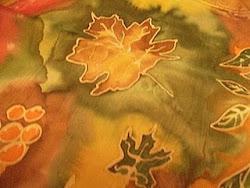Silk was chosen as an artistic surface not only because of its soft, luxurious feel, but also for its practicality. Silk is light, easy to cut into any desired shape and size and is convenient to carry. Chinese artisans prepared the silk for painting by beating it on a stone slab until the surface became very smooth. After the silk was prepared, the color pigments or ink tones were applied slowly and carefully.And what lovely works have survived over the centuries. Bing has a large collection of images of ancient silk paintings; this is just one example:

Western Colorado, where I reside, is fortunate to have a variety of talented artists displaying talents in multiple media effects. Vera Mulder is one such artist who has refined batik painting and has a large following of admirers of her work. As a teacher, painter, photographer and ceramist, she can be found here (with drawing classes the second week of February and more information).
This is one in a series of gorgeous batiks that Mulder showed at The Blue Pig recently:

From All About Fruita:
...a series of batiks titled Rhythms in Red, this batik by Mulder features rich red and lines that create movement for the eye. Cards and prints of the series can be found at Blue Pig Gallery, Palisade, Colorado and Oakley Gallery in the Interiors building, Grand Junction.
 (this one can be viewed at the Oakley Gallery in Grand Junction, CO)
(this one can be viewed at the Oakley Gallery in Grand Junction, CO)And across the pond, from Surrey, United Kingdom, some beautiful paintings on silk can be found at TheWoodFairy's blog, and the author and painter, Betty, has given her permission to show a few of her works here. (If you copy any of her paintings, please be sure to link back to TheWoodFairy.)

Betty's art blog, Imaginary Brushstrokes, can be accessed here.
The Wood Fairy (Betty) gives a tutorial on how she creates paintings on silk which you can also access at this site. Another excellent tutorial on painting on silk can be accessed at this site on Chinese painting.
Betty painted the one below for her brother, saying..
I have included the Celtic symbols for the word 'strength' on one of the oak leaves. The oak is regarded as the symbol of strength.

If you are interested in trying this technique, products are readily available from most art suppliers. Several years ago I purchased fabric dyes and raw silk over the internet. The raw silk was cut to fit six dining room chairs, and then I painted onto the raw silk in colors matching the tile floor on the dining area floor. Those chair seats are still in use, but I have noticed that they need to be refreshed with more paints as the years have faded the colors. Or is it that just the wear of sitting on those cushions has caused the dye to fade? Either way, my next painting project is to re-paint and re-cover those chair seats.
One complete site relating to products needed for painting on silk gives a complete listing of available items including dyes, paints, silk material, resists, etc. This site, Dharma Trading, can be accessed here where I purchased the Jacquard brand dyes and resist products over ten years ago, and the dyes are still strong and vibrant.

For further assistance in painting on silk, a book entitled Beginner's Guide to Silk Painting by Mandy Southan (Search Press Limited, 1997, Great Britain) was my inspiration into dyeing on silk fabric. This little book (available on Amazon) is a gem and highly recommended if you desire further instruction. Southan gives gorgeous pictures and detailed, step-by-step procedures. If I can do it, so can you!

Update: as soon as my husband read this post, he asked when those dining room chairs were going to get reupholstered. Sigh.
